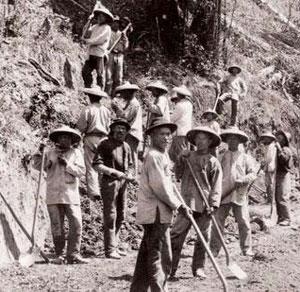This te legram reveals one of the most closely held secrets
legram reveals one of the most closely held secrets
in Pacific Northwest history. It was sent on July 14, 1873 to the revered Seattle pioneer Arthur Denny with an identical copy sent to the opportunistic speculator Mathew McCarver in Tacoma. In a single curt sentence, the powerful Northern Pacific railroad finally declared their intentions for a terminus on the Pacific Coast and in so doing dashed the hopes of Seattle and launched the headiest expectations for the city of destiny.
While the news was like the big bang that created the City of Tacoma’s universe, it came at a time when the launch effort by the Northern Pacific railroad was having a big problem at mission control. The six months between the telegram and the completion of the rail line to saltwater were indeed like a troubled moonshot, plagued by scratchy communication over a vast distance, faulty supply lines and no realistic plan B.
Tacoma’s Apollo 13 episode was called the Prairie Line. It was a risky, frantic race to build the final section of the transcontinental railroad from the railhead at Tenino to the tidewater of Commencement Bay across the prairie and delta of the Nisqually River. With the nation plunged into depression and the NP headquarters in the east preoccupied by looming bankruptcy, all the actors and the entire drama played out here in Tacoma and its surrounds.
An extraordinary thing about the Prairie Line story, unlike most 19th Century frontier adventures, is that it was recorded in remarkable detail almost day by day by company record keepers, newspaper reporters, telegraph operators, diarists and even photographers-including Anthony Carr of the legendary pioneer family.

The high tech telegraph had been pushed ahead to Tacoma and Seattle by the NP so local newspapers, particularly the Kalama Beacon and the Pacific/Tacoma Tribune with reporters in Tacoma, could report on rail laying progress. They all knew what was at stake. A Congressional deadline loomed and if the railroad could not run a locomotive to saltwater by mid December, the entire transcontinental enterprise would be revoked, millions of acres in land grant lost and one of American’s great post civil war ventures blown up like a faulty space craft.
The first sign of a critical problem was the September 18th collapse of the Banking House of Jay Cooke, financier for the Northern Pacific and source of gold for building the line out west. When the gold stopped the ex-miners and spikers laying track near American Lake got leery about getting paid and laid down their tools in late November. They picked up guns and built a barricade to keep the Chinese contract laborers or anyone else from pushing the line ahead. Most of them had seen action in the Civil War and they knew how a trigger worked behind a gun barrel.
 Meanwhile at the Tacoma terminus, the NP point men scrambled to keep a semblance of order, called the Chinese crews off the construction front and assembled a work force of more than 1000 Cantonese born men in tents and sheds on Commencement Bay. Months earlier Chinese crews had completed the grading of the right of way down the steep drop of the hillside to tidewater near modern day 11th street but no rails had been laid. With the deadline less than a month to go it was impossible for a locomotive to reach saltwater and meet the congressional charter deadline set for late December. In the short days and cold rain of late November 1873 , it looked like the telegraph message from July had become meaningless.
Meanwhile at the Tacoma terminus, the NP point men scrambled to keep a semblance of order, called the Chinese crews off the construction front and assembled a work force of more than 1000 Cantonese born men in tents and sheds on Commencement Bay. Months earlier Chinese crews had completed the grading of the right of way down the steep drop of the hillside to tidewater near modern day 11th street but no rails had been laid. With the deadline less than a month to go it was impossible for a locomotive to reach saltwater and meet the congressional charter deadline set for late December. In the short days and cold rain of late November 1873 , it looked like the telegraph message from July had become meaningless.
Counting the Carr family and settlers at old town, the sailors on the ships in the harbor and the various employees and opportunists connected to the railroad Tacoma’s population was about 1500 people who were not native Puyallup and Nisqually. The vast majority were contract laborers from across the Pacific. With construction stopped and the promise of the railroad broken an amazing thing happened. Radiating out from the Prairie Line, the work force began making the city anyway-with hand tools, a few horse teams, dynamite to blast stumps, and steam age grading equipment the crews of about 30 men each began clearing the area around Union Station today for railroad shops and yards. They leveled and widened roads that roughly followed Pacific and Broadway and they used pile drivers and rafts to shape a system of docks, cribbing and bridge works along the shoreline. They did not carve out a frontier town, they put down the pattern of a of a city larger than most of them had ever seen. And given the situation at the time, ever would.
Next time…. The Battle at the Barricade

Tacoma was, is, and will always be a remarkable. Place. The history of The city never ceases to amaze me. I am a transplant here from Texas via Colorado and other parts of the world. I have found my home and I will leave only under duress!
LikeLike